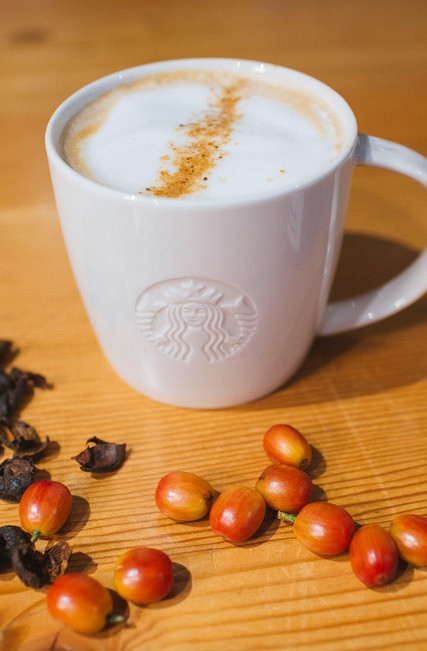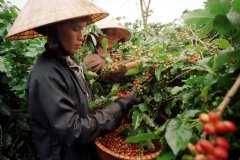The price of coffee peel is higher than that of coffee beans to become the new favorite of global coffee shops, even Starbucks is no exception!

Professional coffee knowledge exchange more coffee bean information please follow the coffee workshop (Wechat official account cafe_style)
The price of coffee skins is higher than that of coffee beans themselves, currently as high as $7 a pound, while the price of coffee beans has fallen to a two-year low of just $1.20 per pound.
Aida Batlle, who grows coffee on his farm in the mountains around the Santa Ana Volcano volcano in El Salvador, used the skins as little as their ancestors did, either as cheap fertilizer or (more often) discarded them.
It was not until one day when she walked past some coffee shells exposed to the sun that she felt an aroma that smelled like hibiscus and other flowers, and was surprised to realize that these coffee shells, which she had long regarded as waste, might be of some value.
So Bateer soaked the skin in hot water to taste it. "I immediately asked the customer to give it a try," she said. "
Today, more than 10 years later, coffee crust (coffee husk), or its better-known name "cascara", is sweeping the world. STARBUCKS recently launched a new drink with cascara syrup in the United States and Canada, and offers a sprinkling sauce made from coffee skins. Competitors STUMPTOWN COFFEE ROASTERS and BLUE BOTTLE COFFEE also add this flavor to the menu and use it in tea or carbonated drinks.
Thanks to the demand of these coffee chains, the price of coffee skins is now higher than that of coffee beans. Bateer says she gets $7 for every pound of cascara she sells. By contrast, the average price of coffee beans hovers around $1.20, a two-year low due to an oversupply of Arabica beans.
Cascara is low in caffeine and tastes less intense than coffee. According to Bateer, in addition to hibiscus, it may also have the taste of papaya or green apple, depending on the cultivation method and location. (
The picture above shows Starbucks' new cascara latte in North America.
Important Notice :
前街咖啡 FrontStreet Coffee has moved to new addredd:
FrontStreet Coffee Address: 315,Donghua East Road,GuangZhou
Tel:020 38364473
- Prev

Vietnamese ethnic minorities try to reverse the reputation of Vietnamese Coffee
Vietnam's ethnic minorities are trying to grow better-quality organic coffee beans to polish the signboard of Vietnamese coffee. Vietnam, which has a reputation as the world's second-largest coffee producer, sells more than instant coffee, they say. Roland Liang GE (transliteration, Rolan Co Lieng) shuttles through the greenhouse to check the caramel yellow coffee beans that have been dried in a net for months. She grabbed a hand and sniffed it.
- Next

Zhang Yuqi also likes "net blue" Luckin Coffee? Weibo photo praise: delicious! Lucky coffee!
Professional coffee knowledge exchange more coffee bean information please follow the coffee workshop (Wechat official account cafe_style) May 24, Zhang Yuqi uploaded a photo, with the caption: delicious! Lucky coffee! In the photo, she is wearing a black net perspective dress, revealing the shoulder and clavicle, sexy and generous. On May 24, Zhang Yuqi uploaded a photo on her Weibo with the caption: Good taste
Related
- A complete list of coffee bean names and their meanings! What is Yejia Shefi coffee? Where is Mantelin coffee?
- What grade does Arida Manor Kaduai coffee beans belong to? What treatment is Arida ASD slow anaerobic sun exposure?
- The milk tea cup becomes smaller?! Overlord Tea Girl launches a new "Return to Yunnan" series
- Accused of selling counterfeit and high-priced coffee beans! Well-known boutique coffee brand "Oukelao" bowed and apologized!
- How to make espresso dumplings? Can I eat coffee and glutinous rice balls together?
- Save the unformed and stagnant powder cakes in one second! What is the problem with stagnant water in the powder bowl of the espresso machine?
- What does hand-brewed coffee stop mean? Why is it not recommended to make coffee by hand?
- Is it normal to smell like coffee? Why does coffee smell like alcohol? What's wrong with the strong smell of cold extract ice dripping ice brewed coffee?
- How to solve the problem that hand-brewed coffee extraction takes too long? Why is the water flowing so slowly when making coffee?
- The main points of making Australian white coffee, the proportion details, how does Australian white properly foam and blend the flowers?

